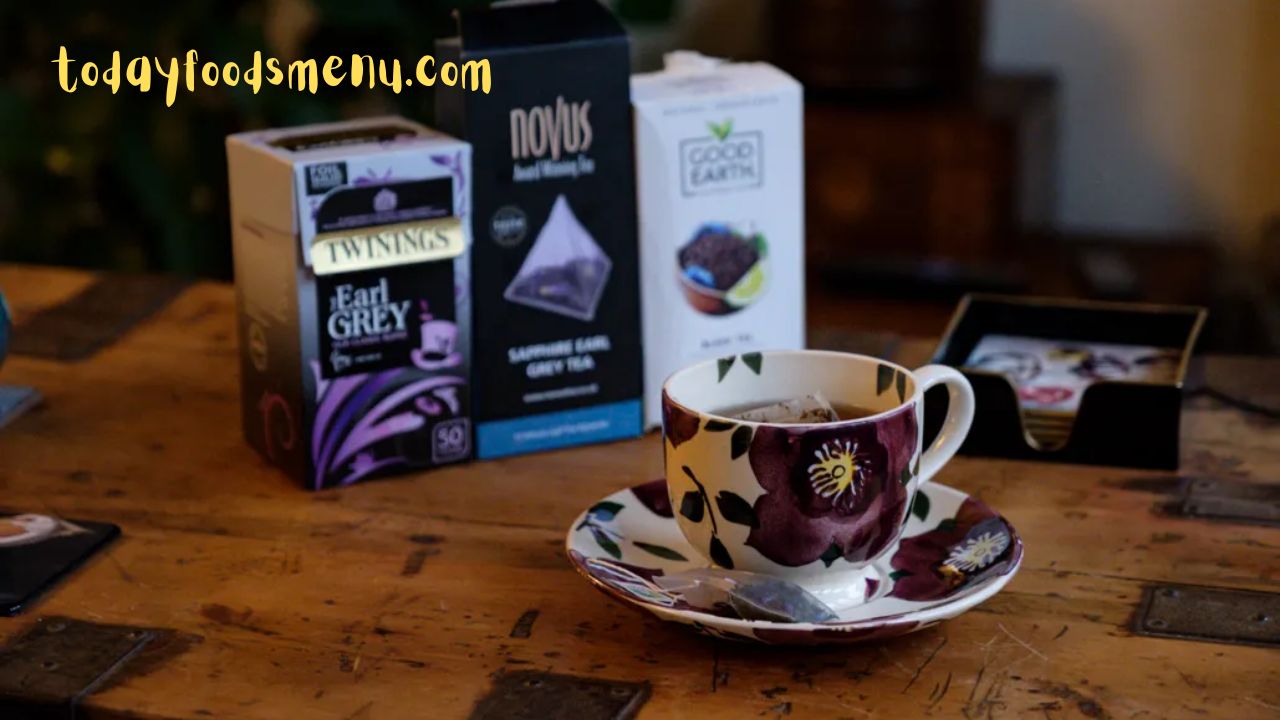Introduction
Best Earl Grey tea is one of the world’s most beloved and widely consumed teas. Its distinctive flavour, which comes from adding bergamot oil, sets it apart from other teas. Whether you’re a seasoned tea drinker or someone new to the world of tea, this guide will help you understand what makes Earl Grey tea the best, how to choose the best one, and the history behind this iconic beverage.
What is Earl Grey Tea?
Earl Grey tea is a flavoured tea that combines black tea with the essence of bergamot, a type of citrus fruit. The origin of the tea is steeped in legend, often attributed to Charles Grey, the 2nd Earl Grey, who was British Prime Minister in the 1830s. The most famous story is that a Chinese Mandarin gave the tea blend to Grey as a gift, and it became a favourite among British tea drinkers.
Today, Earl Grey tea comes in various forms, including traditional black, green, white, and even herbal blends. The essential characteristic of all Earl Grey teas is the presence of bergamot, which gives the tea its distinctive citrusy flavour.
The History of Earl Grey Tea
The history of the best Earl Grey tea is fascinating and somewhat mysterious. The tea was named after Charles Grey, who served as British Prime Minister from 1830 to 1834. According to one famous story, Grey received a gift of tea flavoured with bergamot oil after saving a Chinese Mandarin’s son from drowning. However, historical evidence supporting this story is sparse.
Another theory suggests that the tea was created to mask the taste of lime in the water at the Grey family estate, Howick Hall, in Northumberland. Regardless of its origins, Earl Grey tea became popular in England during the 19th century and has remained a staple ever since.
The Key Ingredient: Bergamot
Bergamot is a citrus fruit primarily grown in Italy. The oil extracted from the peel gives Earl Grey tea its signature flavor. Bergamot is valued not only for its unique taste but also for its aromatic properties. The fruit is a hybrid of lemon and bitter orange, and its oil has been used for centuries in perfumes, cosmetics, and food flavourings.
In Earl Grey tea, the bergamot oil is blended with tea leaves, giving the tea a bright, floral, and slightly tangy flavour. The amount of bergamot used can vary, leading to different flavour intensities in various Earl Grey tea brands.
Types of best Earl Grey tea
While traditional Earl Grey is made with black tea, many variations are available today. Here are some of the most popular types:
Traditional Black Earl Grey
This is the classic version of Earl Grey, made with black tea leaves and bergamot oil. The black tea provides a robust base, while the bergamot adds a refreshing citrus note.
Green Earl Grey
Green Earl Grey tea substitutes green tea for traditional black tea. The result is a lighter, more delicate flavour with a subtle citrusy undertone. This version is perfect for those who prefer the health benefits of green tea but still want the distinctive taste of Earl Grey.
White Earl Grey
White Earl Grey tea uses white tea leaves, less processed than black or green tea leaves. This version is even more delicate and has a milder flavour. The bergamot flavour is often more pronounced because the tea base is subtle.
Rooibos Earl Grey
Rooibos, or red tea, is a caffeine-free herbal tea from South Africa. Rooibos Earl Grey is perfect for those who want to enjoy the flavour of Earl Grey without caffeine. The naturally sweet and nutty flavour of rooibos complements the bergamot beautifully.
Lavender Earl Grey
Best Earl Grey tea includes lavender flowers, which add a floral note to the tea. The combination of lavender and bergamot creates a soothing and aromatic tea experience, perfect for relaxation.
How to select the Best Earl Grey Tea
Selecting the best Earl Grey tea depends on several factors, including personal taste preferences, the tea’s quality, and the brand’s reputation. Here’s what to consider:
Tea Base
The base tea in the best Earl Grey tea can vary. Traditionalists may prefer black tea, while others might enjoy the lighter taste of green or white tea. Rooibos and herbal blends are great for those who want a caffeine-free option.
Bergamot Intensity
Different brands use varying amounts of bergamot oil, which can significantly affect the flavour. Some teas have a strong, citrusy punch, while others offer a more subtle hint of bergamot. Try a few different brands to find the level of bergamot that suits your taste.
Quality of Ingredients
High-quality tea leaves and natural bergamot oil will result in a better-tasting tea. Look for teas that use whole leaves and pure bergamot oil rather than artificial flavourings.
Brand Reputation
Some tea brands are known for their quality and consistency. Twinings, Harney & Sons, and Tazo are well-regarded for their best Earl Grey tea. Experimenting with different brands can help you find your favourite.
Making the Ideal Earl Grey Tea Brew
Brewing the best Earl Grey tea is an art that involves a few simple steps to ensure you get the best flavour. Here’s a guide to making the perfect cup:
Use Fresh, Cold Water
Start with fresh, cold water. The quality of the water can significantly affect the taste of your tea. If possible, use filtered water to avoid any unwanted flavours from tap water.
Heat the Water to the Right Temperature
The water should be heated to around 200-212°F (93-100°C) for black best Earl Grey tea. For green or white Earl Grey, use slightly cooler water, around 170-185°F (77-85°C). Boiling water can scorch delicate green and white teas, making them taste bitter.
Steep for the Right Amount of Time
The steeping time is crucial. For black Earl Grey, steep for 3-5 minutes. Green and white best earl grey tea should be steeped for 2-3 minutes. If you steep the tea too long, it will taste harsh; if you steep it too short, it will taste weak.
Add Enhancements (Optional)
Some people enjoy their Earl Grey with a slice of lemon or a splash of milk. However, purists might argue that the best way to appreciate the bergamot’s flavour is without any additions.
Health Benefits of Earl Grey Tea
Earl Grey tea not only tastes great but also offers several health benefits. The combination of tea and bergamot provides a range of positive effects on the body:
Antioxidants
Earl Grey tea is rich in antioxidants, particularly flavonoids, which help protect the body from free radicals. These antioxidants can improve general health and lower the risk of developing chronic illnesses.
Heart Health
Some studies suggest that the flavonoids in black tea can improve heart health by lowering blood pressure and cholesterol levels. Bergamot also contains compounds that may help lower cholesterol.
Digestive Aid
Bergamot has been traditionally used to aid digestion. Drinking the best Earl Grey tea can help soothe the stomach and alleviate indigestion.
Stress Relief
Bergamot oil is recognized for its soothing properties. Drinking Earl Grey tea can help reduce stress and promote relaxation.
Weight Management
The caffeine in the Best Earl Grey tea can boost metabolism, aiding in weight management. Additionally, the polyphenols in tea can help with fat oxidation.
Popular Brands of Earl Grey Tea
With so many options available, choosing the best Earl Grey tea can be overwhelming. Here are some popular brands that are known for their best Earl Grey tea
Twinings
Twinings is one of the most well-known tea brands globally, and its Earl Grey is a classic. However, they offer several variations, including Lady Grey, a milder version with additional citrus flavors.
Harney & Sons
Harney & Sons are known for their premium teas, and their Earl Grey Supreme is a favourite among tea enthusiasts. It uses a blend of black teas with a generous amount of natural bergamot oil.
Tazo
Tazo offers a bold version of Earl Grey, with a robust flavour and a strong bergamot presence. Their tea bags are convenient for everyday brewing.
Teavana
Teavana, known for its high-quality loose-leaf teas, offers several Earl Grey blends. Their Earl Grey Creme is particularly popular, with a creamy vanilla addition that adds richness to the tea.
Stash Tea
Stash Tea is another famous brand that offers a wide range of the best Earl Grey teas, including Double Bergamot Earl Grey for those who love a strong citrus flavour.
Exploring the Depths of Earl Grey Tea
Earl Grey tea is a fascinating blend that has captivated tea lovers for centuries. While its flavour profile is its most prominent characteristic, there is much more to appreciate about this iconic tea. From its flavour components’ intricacies to its cultural significance and innovative adaptations, there’s a lot to delve into when it comes to Earl Grey.
The Complexity of Bergamot
Bergamot, the citrus fruit that defines the best Earl Grey tea, adds a nuanced layer of refreshing and distinctive flavour. The bergamot orange, a small, greenish-yellow fruit, is native to the Mediterranean region, particularly Calabria in Italy. The fruit’s flavour is a blend of lemon and orange with a hint of spice, making it a unique ingredient for tea.
The process of extracting bergamot oil is quite intricate. The oil is cold-pressed from the fruit’s peel, capturing its aromatic compounds. This essential oil is highly concentrated and needs to be used judiciously to avoid overpowering the tea. Bergamot oil is added in precise amounts in the best Earl Grey tea to ensure a balanced flavour profile.
Conclusion
Earl Grey tea is much more than a simple blend of black tea and bergamot. Its rich history, complex flavour profile, and cultural significance make it a fascinating subject for tea enthusiasts and newcomers. Understanding the nuances of bergamot, the role of the tea base, and the innovations in Earl Grey can enhance your appreciation of this classic tea.


